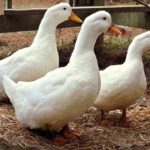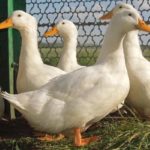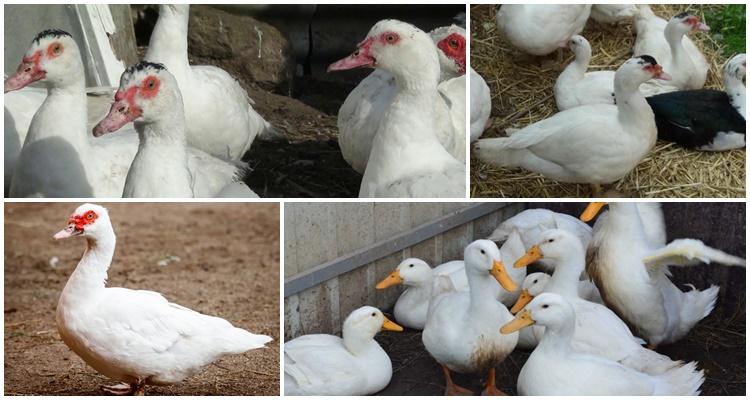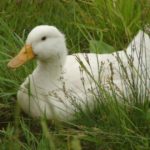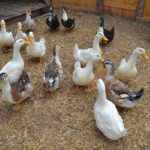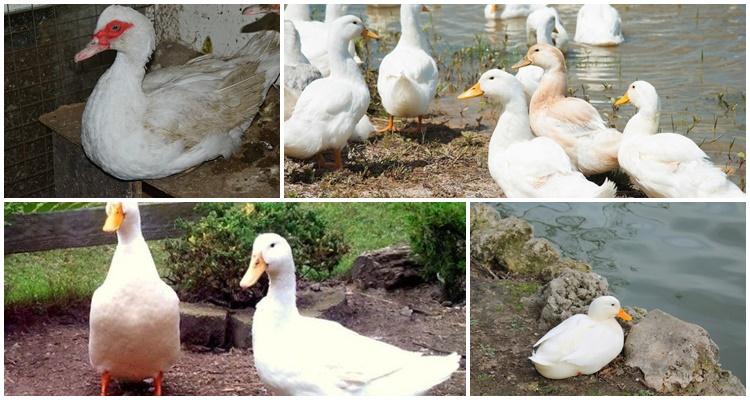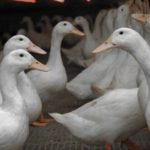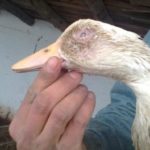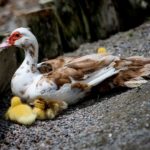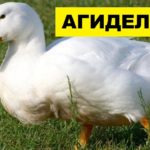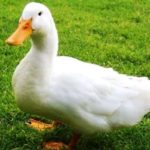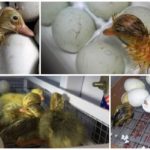Indo-ducks are a popular type of poultry; they are bred on large poultry farms and small farms. In our country, this type of duck appeared at the end of the 20th century and quickly spread due to its early maturity, tasty dietary meat, and impressive weight. Let's consider the features of breeding the French White variety of Indo-duck, the pros and cons of growing, care and possible problems.
Origin story
Above the beak of turkey ducks there is a fleshy growth that makes the bird look like turkeys.The name of the duck also suggests a close relationship with turkeys. But turkey ducks are not hybrids of a duck and a turkey; this popular belief is a misconception. Wild ducks, also called musk ducks (due to their special smell), with leathery growths near the beak, are found in Central and South America. Domestic breeds of Indian ducks are bred from them. Indo-ducks are raised all over the world. The first representatives were brought to Russia from Germany.
White French Indo ducks are distinguished by their snow-white feathers without any shades of gray or yellow. The main feature of the breed - the absence of an obsessive specific duck smell in the meat - was liked by poultry lovers.
Reference: Indo-ducks are also called mute ducks (Europeans are mute) for their inability to quack or make noise loudly, like other representatives of the ducks.
General description and characteristics
Domestic ducks are heavier than their wild relatives. They have a wide chest and a short neck. The weight of an adult varies from 6 kilograms for drakes to 4 kilograms for females. The body length of males reaches 90 centimeters (females – 60 centimeters). Thanks to their short webbed feet, Indian ducks are good swimmers and love to spend time in the water. But in the absence of bodies of water, they make do with staying in the yard and easily tolerate land life.
The plumage is dense, some Muscovy duck species give good fluff. Thanks to their long wings and powerful plumage, Indian ducks fly well, which can be a problem for poultry farmers. The neck is short, the beak is flat. Between the eyes and beak there is a red leathery growth, which is the main distinguishing feature of indo-ducks. If you touch this place in adult individuals, you will notice a slight musky smell, which gives the ducks their name.
Wild individuals have dark feathers, while domestic ones have different colors, from pure white to red-brown. White Indian ducks are distinguished by high productivity - meat yield - 54-60% of live weight, rapid weight gain, a laying hen produces 100-120 eggs per year. Eggs with a large yolk, their weight is 70-75 grams.
Varieties of Indo-ducks
Biological classification divides Indian ducks into only 2 varieties - wild and domestic. Wild Indian ducks are predominantly dark in color, and their body size is significantly smaller than their domesticated counterparts (1.5-2 kilograms).
In addition to the white French ones, several more varieties of Indo ducks have been bred, which differ in the color of their plumage. Cultivated species have a phlegmatic character and are easy to handle even for inexperienced poultry farmers.
Popular breeds also include:
- Mulards - bred by crossing Muscovy and Peking ducks;
- red bull - ducks with red-brown feathers, one of the largest (the drake grows up to 5-7 kilograms);
- blue - has a lavender color of plumage, the fluff is light and delicate, the feather is an additional source of profit when breeding;
- chocolate - Indian ducks with cinnamon feathers and white fluff, as a result, each bird has an individual color.
There is no particular difference in content and character between the breeds; the meat of all is juicy and tender, the differences relate to appearance.
Advantages and disadvantages
White Indian ducks do not have any special requirements for maintenance; they lay eggs for a long time, which allows them to produce offspring twice a year. Keeping Indian ducks does not cause owners much trouble; the breeds have more advantages than disadvantages.
How to keep and care for a bird
What conditions need to be created for white Indian ducks to ensure full development:
- Families are formed from 1 drake and 4-5 laying hens. Females are one month younger than the male. If there are many birds, they are housed in separate families.
- Hatching nests are made from boxes or branches. Laying hens and ducks are separated during hatching.
- Population density – 3 birds per square meter of area, ducklings – 8 heads.
- It is better to make the floor in the poultry house mesh with cells of 24 millimeters, covering 2/3 of the area of the room.
- Muscovy ducks can live without a pond. A large basin of water is placed in the poultry house so that the bird can wet its plumage and wash its beak.
- Indian ducks fly well, so there is a mesh fence on the sides and top. When kept in a yard, the bird's wings are clipped (tubular feathers to ½ length).
- Conditions of detention. The bird does not tolerate dampness or musty, humid air.The poultry house is provided with ventilation and windows, and in the warm season the birds are allowed to roam.
- When keeping an enclosure, the territory is zoned - feeders in one place, a separate area for walking. For musk ducks, they make perches and beds for spending the night, which resemble trees in the wild.
- The recommended temperature is 16-20 °; if it drops below 16 °, the females stop laying eggs. It is recommended to illuminate the poultry house for 16-18 hours.
- After feeding, the containers are emptied of food debris - musk ducks do not like dirt. Change the bedding regularly (ideally large sawdust).
- Incubation is carried out in the spring. During the season, an indo-duck can hatch ducklings twice. Females have a developed maternal instinct; if the eggs are not removed for 2-3 weeks, the duck will sit on the clutch.
- Newborn ducklings are fed 5-8 times a day. Start with eggs, then add cottage cheese. After a week, you can give the usual set of feeds, pre-crushed.
- When walking, the bird likes to peck at small shiny objects (glass, nails), so you need to keep the yard clean.
Slaughter of poultry is recommended no later than 12 weeks of age to avoid stumps during plucking.
Diet planning
White musk ducks are not too demanding on their diet and demonstrate omnivorous behavior. To ensure that the immune system does not suffer and the young animals quickly gain weight, the diet must be balanced. Ducklings and adults are fed the same food; for young animals, food is crushed (fed 5 times). The diet includes:
- grain, bran - wheat, oats, corn, barley;
- green food – grass up to 10% of the total amount of food (including leaves, tops);
- root vegetables - chopped beets, carrots, boiled potatoes;
- meat and fish waste, river shellfish;
- synthetic vitamins, premixes.
If the ducks do not walk, the grass is cut and given at one of the feedings. Indo-ducks eat kitchen scraps well - scraps, leftovers from prepared dishes, pieces of fruits and vegetables. When walking, they eat small insects. If the bird does not walk or swim in a pond, it is important to include bone meal in the diet to provide protein and amino acids of animal origin.
Feed the bird 3 times a day, preferably according to the schedule. Clean water must be constantly available.
Rules and profitability of breeding
Raising White Muscovy Ducks With proper organization of the economy, the business is profitable. The demand for red dietary meat remains consistently high, the market is not full. The carcasses of the white French Indo duck have a pleasant presentation - there are no dark spots on the skin from the dyed feathers, the skin is light in color. What novice poultry farmers need to know:
- There is little demand for duck eggs.
- During seasonal maintenance there is no need for warm poultry houses, which reduces costs. In 2 months, the ducklings will reach their maximum size; they can be sold, making a profit that is 2 times the cost.
- With constant breeding, you will have to spend money on a poultry house. Additional income is usually provided not by eggs, but by the sale of ducklings. If you build a room and feeders yourself, the costs will quickly pay off. If you purchase an incubator, you can buy eggs from other farms and earn income from the sale of chickens.
Before starting breeding, you need to study the possibilities of implementation, the features of the local market, in order to draw up a competent business plan, taking into account all the features of the farm.
Help: farms by breeding indo-ducks for meat have an average profitability of 70%.
Possible diseases
Muscovy ducks have strong immunity and rarely get sick. Among the most common diseases are:
- parasites (feather eaters);
- problems of the digestive tract – goiter catarrh, cloacitis;
- infectious diseases – salmonellosis, aspergillosis (fungal), viral hepatitis, bird flu;
- loss of plumage.
Vaccinations and compliance with housing conditions reduce the risk of developing diseases. In the warm season, turkey ducks are moved outside - the sun and fresh grass strengthen the immune system and maintain the health of young and adult birds. When kept in a poultry house, the temperature and light conditions are observed, and cleanliness and humidity are monitored.
White turkeys produce high quality meat and are not difficult to care for. By starting with a few heads and mastering the rules of cultivation, you can build a profitable business. Indo-ducks grow quickly, have excellent health, and their meat is in demand on the market.



